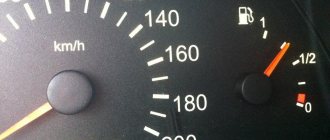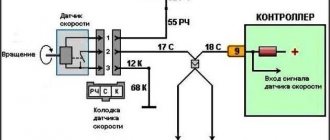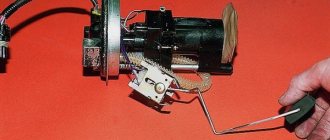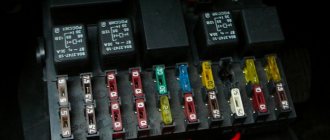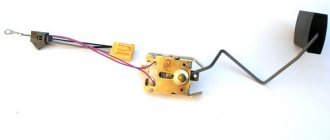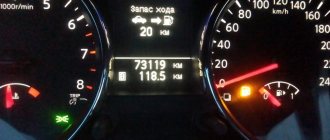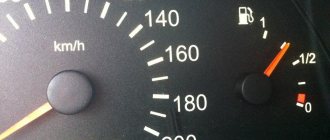It is always important for the driver to know how much mileage the remaining fuel in the tank will last him. The calculation of specific values of instantaneous or average mileage, the number of liters of fuel in the tank, and reserve kilometers is carried out by the on-board computer, but the initial information is supplied to it by the fuel level sensor (FLS).
Since the shape of the tank is unchanged, the volume has a known functional dependence on the level.
The purpose of the fuel level indicator in a car
It is necessary to distinguish between a pointer and a sensor. The first is located on the dashboard and is a dial or digital indicator.
The numbers are in any case duplicated by an analog scale, no matter in the form of a display section or a separate device with a magnetoelectric drive of the needle. This is more of a tribute to tradition than a necessity, but it is accepted.
The pointer is connected to the sensor, and the electrical characteristics of both devices are selected in such a way that the error is minimally acceptable at any point on the scale.
This is interesting: Why is the diesel fuel system airy?
It is not at all necessary to have a linear characteristic of the indicator and FLS. Moreover, they are almost always nonlinear. But when two characteristics are superimposed on one another, and an additional nonlinearity of the scale is added to them, then the displayed information can be trusted.
In the case of computer processing of the sensor signal, you don’t have to worry about the reliability of the readings. The software controller is capable of implementing any most intricate function, even one that cannot be expressed analytically. It is enough to calibrate the readings, which is what is done during development.
The most complex shape of the tank, where, depending on the position of the fuel level, the movement of the sensor’s setting element is influenced by greatly different amounts of liquid in units of volume, is set in the device’s memory in the form of a table.
Moreover, the owner can always enter his own correction factors during the customization procedure for an even more accurate reading. This is how universal on-board computers installed as additional equipment usually work.
Device location
The FLS is always located directly in the fuel tank. Its design is resistant to gasoline or diesel fumes, and access is through a flange at the top of the tank, usually combined with a service port for the fuel pump.
The sensor itself is also often included in a single module with it.
Causes of malfunction
The reasons why the fuel level sensor does not work or it shows incorrectly are the following faults:
- The float has lost its seal. This situation is relevant when a ball made of fragile plastic is used as a float, which can crack as a result of mechanical stress or as a result of operating the car in severe frosts. In this case, the float will be inside the liquid or, more often, it will simply sink and fall to the bottom. The result will be a constant reading from the device that there is no fuel in the tank. Repair measures include replacing the float or the entire assembly. Another rare option is that the float can simply detach from the lever on which it is attached and “go off on its own.”
- Deformation of the lever that holds the float. As a result, the float may lose mobility or reflect incorrect information. Often this situation occurs when the fuel module is inaccurately removed from the tank, but sometimes even as a result of long-term operation of the car on roads with uneven surfaces, that is, with constant vibrations while driving. You can try to return the lever to its original shape, but most often the corresponding lever is simply replaced with a new one.
- Damage to the sensor housing. As a result, the readings of the resistive elements may change or the lever that takes the corresponding readings may be damaged. In this case, the reason why the sensor does not show the fuel level correctly is the use of low-quality gasoline or mechanical shock loads on the part.
- Failure of resistive elements. This is a fairly common reason why the fuel level sensor does not work. Elements on the rheostat fail for natural reasons, that is, as a result of abrasion during long-term use. It is possible that the wear is partial, for example, in the middle. In this case, the instrument needle will twitch. It is also possible that there is no contact between the sliding element and the resistive track due to damage or wear of the resistive coating or loosening of the slider foot pressure. With such a malfunction, the arrow will lie at zero.
- Lack of electrical contact in a certain section of the circuit. As a rule, on contacts that are oxidized either by moisture or fuel. The wires, their insulation, or breakage may be damaged. There are also sometimes problems with electrical connectors.
- The signal wire has a short to ground. In this case, the value of its resistance will be distorted and tend to zero. With such a malfunction, the level sensor incorrectly displays the level, transmitting information that the tank is completely filled.
- The fuse responsible for the operation of the fuel level sensor has blown. The fuse number must be found in the electrical diagram of the specific vehicle.
- Failure to secure the sensor on the fuel tank body. For example, with a skew. As a rule, in such a situation, the smell of fuel spreads outwards, in particular, the smell of gasoline will be heard in the cabin.
- There are cases when the resistive board on which the slider moves simply falls off the fastening solder.
- Tubular fuel level sensors may have a broken signal wire. In this case, the arrow will constantly show an empty tank.
- Also, tubular sensors are characterized by a coating that can form on the guide post. This will naturally make it difficult (and even impossible) for the float to move. Plaque is usually formed as a result of using low-quality fuel (with a large amount of paraffin, gasoline instead of gasoline). In this case, the instrument needle will freeze in one position, and not necessarily in one of the extreme ones.
- For non-contact sensors, the magnetic sensor and/or its wiring may be damaged. Some of them have a special control and control board installed. The problem may be with her too. In this case, the sensor usually fails completely, that is, it does not indicate the fuel level at all.
Most often, problems arise with floats or resistive elements, which wear out over time and stop transmitting correct data. But note that when the fuel level is not displayed, it is not always the sensor that is to blame. Often the arrow does not work, and here the device on the panel, which, in fact, is a potentiometer, is to blame. Therefore, if the fuel sensor does not indicate the fuel correctly, then you need to remove it and check it with a multimeter and make a visual inspection.
Types of fuel level sensors
There are many principles for converting position into an electrical signal.
Some record exactly the position of the liquid level, that is, the boundaries between substances of different densities, but it is quite possible to measure the volume directly. There is no particular need for this, and the devices will be more complex and expensive.
There are several basic principles:
- electromechanical;
- electromagnetic;
- capacitive;
- ultrasonic.
There may also be differences in the method of communication with the pointer:
- analog;
- frequency;
- pulse;
- encoded directly from the data bus algorithm.
The simpler the device, the larger volumes it is produced; the price is almost decisive. But there are also special applications, such as commercial or sports, where accuracy and stability are more important.
Location
To begin repairs, you need to become familiar with the wiring diagram of automobile fuel level sensors, as well as their location and types.
The first question is simple but important. This is where the required fuel level sensor in the car should be located. Everything is simple here. It is located directly inside the fuel tank. The only difference is in the design of the controller itself.
Also, sometimes the sensor is built into the design of the fuel module, that is, it is a single integral device. It consists of the following components:
- current level display sensor;
- check valve;
- filter;
- sediment for pumping fuel.
Or it can be installed separately. Somewhere on the side or in the middle of the tank. This scheme can be used on diesel and gasoline engines.
Design and principle of operation
Most often, control of the surface is carried out using a float. It can connect to the converter in different ways.
Float
The simplest thing is to connect the float to the measuring potentiometer using a lever. Moving the position of the current collector causes the resistance of the variable resistor to change.
It can be in the simplest wire design or in the form of a set of resistors with taps and contact pads along which a slider moves, connected to the float through a lever.
Such devices are the cheapest, but also the most inaccurate. When connecting a computer, they have to be calibrated using test fills with known volumes of fuel.
Magnetic
You can get rid of the lever by connecting the potentiometer to the float using a magnet. A permanent magnet connected to the float moves along the system of contact pads with taps from film resistors of a calibrated value. Above the platforms there are steel flexible plates.
Depending on the position of the magnet, one of them is attracted to it, closing on the corresponding pad. The total resistance of a set of resistors changes according to a known law.
Electronic
The presence of electronic components in the sensor allows a wide variety of devices to be classified in this category. For example, a capacitive sensor, where two capacitor plates are located vertically in a tank.
Causes
Now you need to find out why this sensor on your car does not display the current fuel level correctly and what is causing this.
There are several potential reasons. Therefore, each of them needs to be considered in detail.
- Violation of the tightness of the installed float. It is found on sensors where the float is made in the form of a ball made of fragile plastic. With mechanical shocks, as well as under the influence of extreme cold, the material is destroyed. If the seal is broken, the float simply remains on the surface of the liquid or sinks. As a result, the controller shows that there is no fuel. For repairs, it is necessary to replace the float separately, or the entire sensor. Much less often, the float part is disconnected from the lever and begins to move independently inside the container.
- Lever damage. Due to its deformation, the float loses mobility or transmits information incorrectly. The cause of the problem is long driving. Moreover, on uneven and bad roads. Or in violation of the rules for dismantling the fuel unit from the tank. You can try to restore the lever. But more often repairs are carried out by replacing it.
- Deformation of the controller body. Because of this, the installed resistive elements give incorrect readings, or the lever is damaged and does not record data correctly. The reason is the filling of low-quality flammable liquid, or mechanical stress.
- Breakage of resistive elements. A common reason why the FLS stops working correctly. It occurs due to natural causes. That is, resistors wear out from a long service life. The contact between the elements disappears, and the arrow ends up at zero, or simply twitches.
- There is no contact on the electrical circuit section. This happens on those contacts that can simply oxidize over time due to exposure to moisture or the fuel itself. Wires are damaged, the integrity of the insulation is compromised, breaks occur, etc. Sometimes the reason lies in the electrical connectors.
- FLS wire shorted to ground. This occurs precisely with the signal wire, which begins to short to ground. As a result, the FLS indicators become incorrect, and the resistance tends to zero. No matter how much fuel is filled, the sensor will show a fictitious full tank.
- Burnt fuse. The car has a sensor that is responsible for the FLS. The specific fuse number should be found in the owner's manual for your specific vehicle.
- Failure of the fastening on the housing inside the fuel tank itself. As a result, the sensor fell into the tank or was distorted. Usually accompanied by the spread of fuel odors into the cabin.
- Break on the signal wire side. Found on tubular sensors. Then the arrow constantly indicates that the fluid tank for operating the internal combustion engine is empty.
- Plaque formation. Another characteristic feature of tubular type controllers. Plaque accumulates on the guide post. This interferes with the normal and free movement of the installed float. The deposit appears due to the filling of low quality fuel. The arrow stops in one static position.
- Damage to the magnetic sensor, wires. Relevant for contactless fuel level monitoring devices. Some FLS models of this type have control and control boards. Problems happen to them too. Then the sensor completely fails, and the correct fuel level is not displayed.
Practice shows that most often problems are observed from the resistive elements, as well as the float. They wear out over time and can no longer display and transmit data correctly.
Don't immediately blame the sensor. There is a possibility that the arrow of the device is broken, or there are faults on the side of the wires connecting the elements.
Common problems
FLS failures are recorded based on noticeably erroneous readings or their complete absence. In the most common case of a mechanical connection with a float and an analog potentiometer, the indicator needle begins to twitch, increasing or decreasing the readings. This is almost always associated with mechanical wear of the contact group of the variable resistor.
The second common case is a change in the density of the float due to degradation of the material or filling it with fuel. Up to complete drowning and constant zero readings.
If electronic sensors malfunction, they simply stop giving readings. Sometimes this is due to wiring, which is less protected from external influences. Indicators fail much less often.
Messages 14
1 Topic by toljan.66rus 2014-01-21 18:57:03
- toljan.66rus
- Participant
- Inactive
- Registration: 2013-06-27
- Messages: 35 Thanks : 15
- Auto: 2110
Topic: Resolved: The fuel level needle moves by itself, replacing the FLS did not help
hello everyone. such a problem. the fuel level needle moves on its own. it will rise then drop to a minimum and the light will come on, then it will rise again and the light will go out. today I installed a new FLS, still the same. I bought the FLS with the same numbers as the old one. tell me what it is maybe that's the case. I'm already starting to think about the instrument panel. A panel with one narrow window. but when I turn on the ignition the arrows run back there and show what seems to be the correct level
2 Reply from Admin 2014-01-21 19:11:20
- Admin
- Administrator
- Inactive
- Registration: 2012-02-20
- Messages: 3,257 Thanks : 624
Re: Resolved: The fuel level needle moves by itself, replacing the FLS did not help
toljan.66rus , if we exclude the FLS and jammed needle (since the test passes), then there are several more possible reasons: -You need to check the contacts on the rear panel of the tidy. Remove the instrument panel, tighten the small nuts on the back side that are screwed to the indicators to create contact. -Check all the masses, especially the one located under the handbrake. -The instrument panel may be faulty; if it is an old model, it can be repaired. -The float in the gas tank may be stuck.
Methods for repairing the fuel level indicator
Modern FLS cannot be repaired and must be replaced as an assembly. After checking the wiring and testing the resistance at the connector, the sensor is removed from the tank along with the pump and float on the lever.
This will require access to the top of the tank, usually located under the rear seat cushion or in the trunk. The sensor is removed from the pump module and replaced with a new one.
An exception may be observed breaks in the wiring. Soldering and insulation of break points is carried out. But usually the cause of failure is wear of the friction surfaces in the potentiometer.
Restoring it is theoretically possible, but impractical; a repaired device is unreliable, and a new one is inexpensive.
How to fix the problem?
If the fuel sensor is not working correctly, repair work will be required. For each car model, the process of dismantling this device may differ significantly and may also require special tools. However, the general steps are similar and are as follows:
- the negative terminal is disconnected from the battery;
- access to the device is provided by removing the trunk trim;
- unscrew the mounting bolts that fix the position of the sensor, and remove the plate;
- the product is dismantled, the metal elements are cleaned (if it will be used again).
It is necessary to remove the FLS only after disconnecting all wires and foreign elements. The product should be removed easily, without visible effort. On older cars, the device may become stuck: in this case, it will need to be lubricated with a special liquid (for example, WD).
